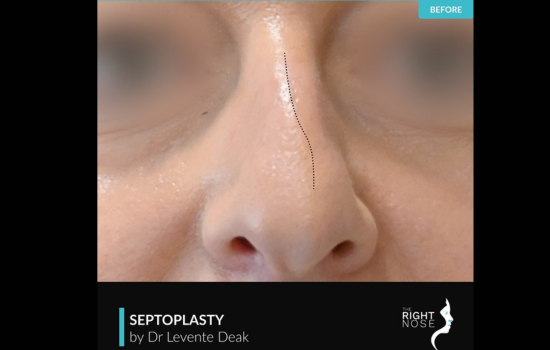Deviated Septum vs. Collapsed Nose: What’s Causing Your Breathing Trouble?
Ethnic Rhinoplasty: Preserving Cultural Identity While Enhancing Aesthetic Appeal
Most of us take breathing freely for granted until it becomes difficult. If you often struggle to get enough air through your nose, wake up with headaches, or constantly feel blocked when breathing in, three common culprits may be to blame: a deviated septum, a collapsed nosing sidewall or turbinate hypertophy
While the symptoms of both can overlap, understanding the main difference is essential to make the right treatment plan and long-term relief.
This blog will explain the details about deviated nasal septum, what causes one, the difference between a deviated septum and nasal valve collapse, symptoms to look out for, available treatment options, and practical tips for managing breathing problems.

What Is a Deviated Septum?
The nasal septum is the thin wall comprising cartilage and bone separating the two nostrils. In an ideal situation, it sits perfectly in the middle, allowing air to flow evenly.
A deviated septum forms when this wall is displaced to one side, partially blocking one or both nasal passages.
What causes a deviated septum?
- Congenital factors: Some people are born with it.
- Trauma or injury: Injury to the nose during childhood or adulthood can cause nasal deviation.
- Age-related changes: Cartilage can shift over time, worsening symptoms with age.
Symptoms of a Deviated Septum
- Persistent nasal obstruction or blocked nose one side
- Deviated septum headaches everyday, often due to sleeping problem
- Snoring
- Nosebleeds from dryness because uneven airflow
- Difficulty breathing during exercise or at night
What Is Nasal Valve Collapse (Collapsed Nose)?
The nasal valve is a narrowest portion of the nasal passage, made up of delicate cartilage and soft tissues. If this area weakens or collapses inward during breathing, airflow is restricted. This condition is called nasal valve collapse or “collapsed nose.”
Causes of Nasal Valve Collapse
- Previous nasal surgery or trauma
- Weak or thin cartilage
- Age-related tissue weakening
- Congenital structural issues
Symptoms of Nasal Valve Collapse
- Severe difficulty breathing, while inhaling
- Nasal obstruction that worsens with exercise or deep breaths
- A “pinched” appearance of the nose
- Mouth breathing, particularly at night
Deviated Septum vs. Collapsed Nose: Key Differences
Feature | Deviated Septum | Nasal Valve Collapse |
Cause | Displacement of the nasal septum | Weakening or inward collapse of nasal valve |
Main Symptom | Constant one-sided blockage, headaches, congestion | Obstruction that worsens during inhalation or exertion |
Appearance | Nose may look crooked or off-centre | Nose may appear pinched or collapsed |
Treatment | Deviated septum surgery (septoplasty) or septo-rhinoplasty | Surgical reinforcement of nasal valve, often combined with septo-rhinoplasty |
Both conditions can coexist, so an accurate diagnosis by an experienced ENT specialist is essential.
Treatment Options: From Relief to Long-Term Fix
Non-Surgical Measures
- Nasal sprays or decongestants (temporary relief)
- Using humidifiers to reduce dryness
- Sleeping in the best sleep position for deviated septum (on the side opposite the obstruction)
- Breathing strips to temporarily open nasal passages
Surgical Solutions
- Deviated septum fix (septoplasty): Straightens the septum to improve airflow.
- Septo-rhinoplasty: Corrects both internal breathing problems and external nasal appearance.
- Nasal valve repair: Strengthens or reconstructs weakened valve structures.
It is a daycare surgery and takes only around 30 minutes. You can recover in 3 days. Surgery is often the only permanent solution when symptoms significantly impact breathing, sleep, or quality of life.
What Happens If You Don’t Fix a Deviated Septum?
Leaving a deviated septum untreated can worsen sinus infections, contribute to chronic headaches, cause poor sleep quality, and even affect your overall energy levels. While mild cases may be manageable with lifestyle adjustments, severe deviation almost always requires medical intervention.
Why Choose Dr Levente Deak?
- European Board-Certified ENT Surgeon and USA & EU Dual Board-Certified Facial Plastic Surgeon
- Esteemed member of Royal College of Surgeons and European Academy of Facial Plastic Surgery (EAFPS)
- Recognised globally for nasal and facial surgical procedures with a focus on nasal surgeries
- Over 20 years of experience performing intricate surgeries such as Rhinoplasty, Blepharoplasty, and Endoscopic sinus surgery
- Pioneer in precise surgical results that balance function and aesthetics
- Follows minimally invasive, same-day surgeries, which ensure quicker recovery and accurate outcomes.
Deviated Septum vs. Collapsed Nose – Which One Is Affecting You?
If you are struggling with chronic nasal obstruction, daily headaches, or difficulty breathing, especially at night, your problem could be due to either a deviated septum, a collapsed nose, or even a combination of both. While the two conditions share similar symptoms, their causes and treatments differ.
A deviated septum blocks airflow due to a crooked septum, while nasal valve collapse occurs when weak cartilage obstructs the narrowest part of your nasal airway. Both can significantly impact your breathing, sleep, and quality of life.
The reassuring news is that advanced procedures such as septo-rhinoplasty and nasal valve repair can effectively correct these problems. Under the expertise of Dr. Levente Deak, patients
Some Quick FAQs
Yes. Since the nasal valve is the narrowest part of your airway, collapse leads to significant obstruction, making it hard to inhale properly.
Absolutely. Patients may struggle with nasal obstruction and mouth breathing when the septum blocks airflow on one or both sides.
A deviated septum is a crooked nasal wall inside the nose, while nasal valve collapse involves weakened cartilage at the narrowest part of the nasal airway.
Yes. Most patients experience substantial improvement in airflow and reduction in symptoms after surgery.
Chronic congestion, sinus infections, poor sleep, and frequent headaches are common consequences.
Yes. Many patients notice increased difficulty when lying on the side of the blockage, which is why the best sleep position for deviated septum is usually the opposite side.





